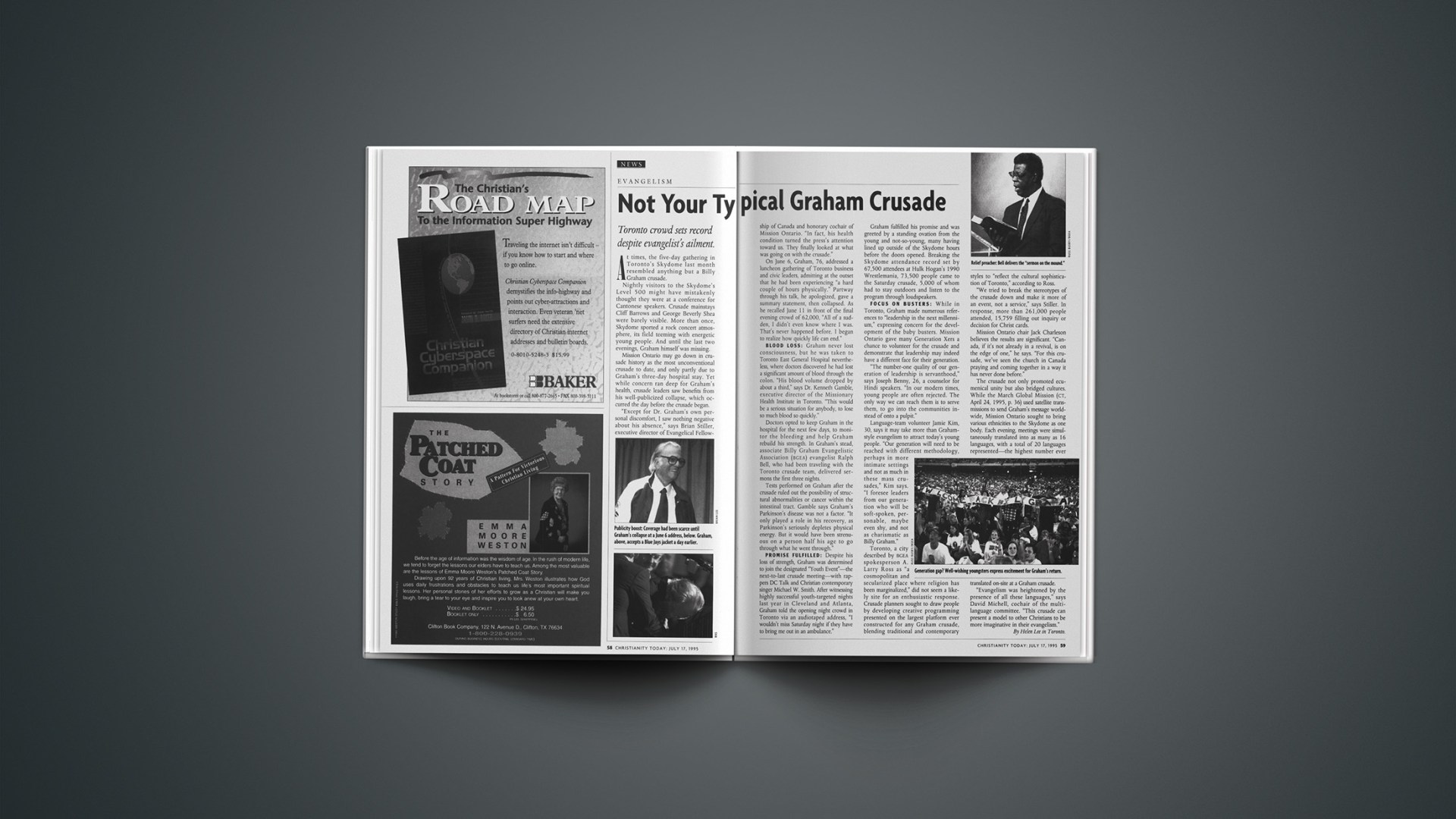At times, the five-day gathering in Toronto’s Skydome last month resembled anything but a Billy Graham crusade.
Nightly visitors to the Skydome’s Level 500 might have mistakenly thought they were at a conference for Cantonese speakers. Crusade mainstays Cliff Barrows and George Beverly Shea were barely visible. More than once, Skydome sported a rock concert atmosphere, its field teeming with energetic young people. And until the last two evenings, Graham himself was missing.
Mission Ontario may go down in crusade history as the most unconventional crusade to date, and only partly due to Graham’s three-day hospital stay. Yet while concern ran deep for Graham’s health, crusade leaders saw benefits from his well-publicized collapse, which occurred the day before the crusade began.
“Except for Dr. Graham’s own personal discomfort, I saw nothing negative about his absence,” says Brian Stiller, executive director of Evangelical Fellowship of Canada and honorary cochair of Mission Ontario. “In fact, his health condition turned the press’s attention toward us. They finally looked at what was going on with the crusade.”
On June 6, Graham, 76, addressed a luncheon gathering of Toronto business and civic leaders, admitting at the outset that he had been experiencing “a hard couple of hours physically.” Partway through his talk, he apologized, gave a summary statement, then collapsed. As he recalled June 11 in front of the final evening crowd of 62,000, “All of a sudden, I didn’t even know where I was. That’s never happened before. I began to realize how quickly life can end.”
BLOOD LOSS: Graham never lost consciousness, but he was taken to Toronto East General Hospital nevertheless, where doctors discovered he had lost a significant amount of blood through the colon. “His blood volume dropped by about a third,” says Dr. Kenneth Gamble, executive director of the Missionary Health Institute in Toronto. “This would be a serious situation for anybody, to lose so much blood so quickly.”
Doctors opted to keep Graham in the hospital for the next few days, to monitor the bleeding and help Graham rebuild his strength. In Graham’s stead, associate Billy Graham Evangelistic Association (BGEA) evangelist Ralph Bell, who had been traveling with the Toronto crusade team, delivered sermons the first three nights.
Tests performed on Graham after the crusade ruled out the possibility of structural abnormalities or cancer within the intestinal tract. Gamble says Graham’s Parkinson’s disease was not a factor. “It only played a role in his recovery, as Parkinson’s seriously depletes physical energy. But it would have been strenuous on a person half his age to go through what he went through.”
PROMISE FULFILLED: Despite his loss of strength, Graham was determined to join the designated “Youth Event”—the next-to-last crusade meeting—with rappers DC Talk and Christian contemporary singer Michael W. Smith. After witnessing highly successful youth-targeted nights last year in Cleveland and Atlanta, Graham told the opening night crowd in Toronto via an audiotaped address, “I wouldn’t miss Saturday night if they have to bring me out in an ambulance.”
Graham fulfilled his promise and was greeted by a standing ovation from the young and not-so-young, many having lined up outside of the Skydome hours before the doors opened. Breaking the Skydome attendance record set by 67,500 attendees at Hulk Hogan’s 1990 Wrestlemania, 73,500 people came to the Saturday crusade, 5,000 of whom had to stay outdoors and listen to the program through loudspeakers.
FOCUS ON BUSTERS: While in Toronto, Graham made numerous references to “leadership in the next millennium,” expressing concern for the development of the baby busters. Mission Ontario gave many Generation Xers a chance to volunteer for the crusade and demonstrate that leadership may indeed have a different face for their generation.
“The number-one quality of our generation of leadership is servanthood,” says Joseph Benny, 26, a counselor for Hindi speakers. “In our modern times, young people are often rejected. The only way we can reach them is to serve them, to go into the communities instead of onto a pulpit.”
Language-team volunteer Jamie Kim, 30, says it may take more than Graham-style evangelism to attract today’s young people. “Our generation will need to be reached with different methodology, perhaps in more intimate settings and not as much in these mass crusades,” Kim says. “I foresee leaders from our generation who will be soft-spoken, personable, maybe even shy, and not as charismatic as Billy Graham.”
Toronto, a city described by BGEA spokesperson A. Larry Ross as “a cosmopolitan and secularized place where religion has been marginalized,” did not seem a likely site for an enthusiastic response. Crusade planners sought to draw people by developing creative programming presented on the largest platform ever constructed for any Graham crusade, blending traditional and contemporary styles to “reflect the cultural sophistication of Toronto,” according to Ross.
“We tried to break the stereotypes of the crusade down and make it more of an event, not a service,” says Stiller. In response, more than 261,000 people attended, 15,759 filling out inquiry or decision for Christ cards.
Mission Ontario chair Jack Charleson believes the results are significant. “Canada, if it’s not already in a revival, is on the edge of one,” he says. “For this crusade, we’ve seen the church in Canada praying and coming together in a way it has never done before.”
The crusade not only promoted ecumenical unity but also bridged cultures. While the March Global Mission (CT, April 24, 1995, p. 36) used satellite transmissions to send Graham’s message worldwide, Mission Ontario sought to bring various ethnicities to the Skydome as one body. Each evening, meetings were simultaneously translated into as many as 16 languages, with a total of 20 languages represented-the highest number ever translated on-site at a Graham crusade.
“Evangelism was heightened by the presence of all these languages,” says David Michell, cochair of the multi-language committee. “This crusade can present a model to other Christians to be more imaginative in their evangelism.”
Copyright © 1995 Christianity Today. Click for reprint information.
ctcurrmrw5T8058576b










